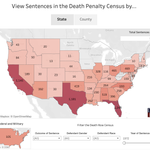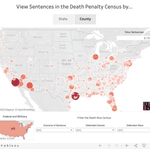Death Penalty Census Database
Database of more than 9,800 death sentences imposed from June 29, 1972 - January 1, 2025
Codebook
A comprehensive guide to the Death Penalty Census
On June 29, 1972, the United States Supreme Court decided Furman v. Georgia, striking down all existing death penalty laws in the United States and ushering in the modern era of the U.S. death penalty. In the decades that followed — as jurisdictions revised their death-sentencing procedures in response to the Supreme Court’s rulings on capital punishment — thousands of people were sentenced to death.
The Death Penalty Census is DPI’s effort to identify and document every death sentence imposed in the U.S. since Furman. The census captures more than 9,800 death sentences imposed between the Supreme Court’s issuance of the Furman ruling and January 1, 2025. These sentences were imposed in 1,280 counties across 40 states, as well as by the federal government and the U.S. Military.
The census tracks every death sentence imposed, listing the name, race, and gender of the person sentenced to death; the jurisdiction (state/federal/military and county/federal district/military branch) in which the charges were brought; the year the sentence was imposed; a multi-sentence code to identify whether the defendant’s death sentence was reversed and reimposed on retrial or resentencing and whether the defendant was also sentenced to death in a separate case; the outcome of the sentence; and the ultimate outcome of the case.
The data reveal that the single most likely outcome of a death sentence imposed in the United States is that the sentence or conviction is ultimately overturned and not re-imposed. Nearly half of the sentences (49.9%) were reversed as a result of court decisions. By comparison, fewer than one in six (15.7%) death sentences ended in execution.
Note: In the graphic above, “On Death Row” refers to active death sentences, plus grants of relief that are still subject to appeal and are therefore not final. Sentences with a final grant of relief, in which the prisoner is awaiting resentencing or retrial, are included in “Reversal” on the Sentences tab, but in “Reversal Not Final” on the Cases tab, because the sentence has been overturned, but the defendant could still be resentenced to death on retrial. The case status number totals on the database view will be different than those displayed in the Tableau visualization above because the numbers are answering slightly different questions. On the Cases tab, the visualization answers “how many cases have a particular outcome?”. The database answers “how many sentences have a particular case outcome?”. The number of exonerations differs from DPI’s Exoneration List because the Exoneration List includes people sentenced to death before 1972 (if they were exonerated after 1973) and people exonerated after April 1, 2024.
The totals in the above graphic will be greater than the total number of sentences or cases in the database, because some cases are counted in two categories. For example, exonerations are counted in both “Exoneration” and “Reversal.”
In compiling the Death Penalty Census, DPI started with our existing death-row, execution, exoneration, and commutation databases and our annual tracking of new death sentences imposed in the U.S. We built on that database by obtaining national, state, and county databases from researchers, departments of corrections, legal defense organizations and prosecutors, and advocacy groups. We also conducted our own independent review of media archives and available court records. Where databases employed different definitions or had inconsistent or contradictory data, we reconciled the differences and then engaged in a multi-step process to verify the data.
To DPI’s knowledge, the Death Penalty Census is the most comprehensive compilation of information on individual death sentences ever assembled. No other database exists that tracks every death sentence in the U.S. since 1972. A project years in the making, the Death Penalty Census is intended to provide clarity on an important, but often poorly or disparately documented, facet of the American legal system. It is our hope that the census database will foster additional research on the subject and enable the public, the media, academics, advocates, government officials, and others working in the death penalty field to engage in educated discourse and make informed decisions.
News & Developments
News
Aug 29, 2024
Death Penalty Census Now Complete Through January 1, 2024
The Death Penalty Information Center has updated its Death Penalty Census database to include new death sentences, exonerations, resentences, removals from death row, and other status changes up to January 1, 2024. DPI’s Census is a unique, comprehensive collection of every death sentence imposed since 1972, with information on the county and state of prosecution; the year and outcome of each sentence; and the name, race, and gender of the defendant. It contains…
Read MoreNews
Oct 20, 2023
DPIC Releases Update to Death Row Census
The Death Penalty Information Center has updated its Death Penalty Census, a database of every death sentence imposed since 1972. The database now contains information accurate as of January 1, 2022, inclusive of the 50th year of the modern death penalty. The Census contains information on 9,820 death sentences imposed on 8,842 defendants. It includes the name, race, and gender of each defendant, along with the region, state, county, and year in which the…
Read MoreNews
Jun 29, 2022
On Anniversary of Furman v. Georgia, DPIC Census of U.S. Death Sentences Details 50 Years of Arbitrariness, Bias, and Error
On the 50th anniversary of the U.S. Supreme Court’s June 29, 1972 decision in Furman v. Georgia that struck down all existing death penalty laws, the Death Penalty Information Center released its Death…
Read More

